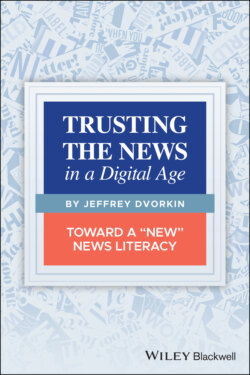Читать книгу Trusting the News in a Digital Age - Jeffrey Dvorkin - Страница 12
“How Do We Know?”
ОглавлениеHow do we know what we know? Just because it’s in a newspaper or on a website, does that mean it’s true? Where does this information come from? Is it reliable or merely a bit of unsubstantiated gossip? Why should we trust this information? And what might happen if we don’t ask skeptical and tough questions?
This is what journalists and informed citizens need to ask, both of themselves and of the people who are providing the information. We need to demand that our media be more transparent. This means asking news sources to be open with the public about where the stories are originating, who the sources of information are, and, if the sources can't be identified, why.
We need to question how reporters got their story, who gave it to them, how it was presented, and why it was presented in the form it was presented in. We especially must focus on the why of the famous “who, what, when, where, how, and why” rule of journalism
The Five Ws, are questions whose answers are considered basic in information‐gathering. They include: who, what, when, where, and why. The Five Ws are often mentioned in journalism research and police investigations. They constitute a formula for getting the complete story on a subject. According to the principle of the Five Ws, a report can only be considered complete if it answers these questions starting with an interrogative word:[3]
Who is it about?
What happened?
When did it take place?
Where did it take place?
Why did it happen?
But in the digital age, when the origin of the information may be less evident, we still need to ask an “H” question: “How Do We Know?” This is a more complicated but even more essential question which relates to how news organizations are able or willing to show how a story is reported. This is called media accountability.
Media accountability is an essential requirement, especially with digital media.
Accountability, like transparency, is about acknowledging ownership of the reporting. It allows the public to connect with the news organization directly. This has been done through the comments section found at the close of a report posted online and via letters to the editor in daily newspapers. These allow news organizations to give the public a way to comment on the value of the reporting. It also gives the editors a sense of what works for and with the public. It also gives a sense of interactivity or a connection with the audience. The question is whether this is just a gesture on the part of the news organization, or if it is an effective approach to connecting with the public in this digital era.
Similarly, the role of a public editor, or news ombudsman, has been useful in creating a way in which news consumers can express their opinions and file a complaint about specific coverage. The changing role of the audience as both participant and observer of the news in the digital environment will also be explored in this book.
In the digital era, the news is everywhere. We see headlines on a TV screen or on a front page. We may have a good sense of what is going on even if we don't know the details. Of the Five Ws, we sometimes don't know the “why” of the news. Why did something happen, and what are the implications? In 2006, Bill McKibben wrote about the “Age of Missing Information” in a book of the same title. McKibben watched an entire day's worth of television and subjected himself to this sensory overload in an experiment to verify whether we are truly better informed than previous generations. He concluded that without the “why” of news (also known as putting the story in context), he was less well‐informed than if he hadn’t watched TV at all.
Since then, it seems that the issues outlined by McKibben have worsened. News literacy gives us the tools to make sure that if information is hidden, we can know how to find it and why it may have been hidden in the first place.
From the late nineteenth century through 2008, the City News Bureau was an essential part of Chicago's local news landscape. It was the legendary basis for all the news that found its way into Chicago newspapers, radio, and television newscasts. It even had its own motto: “If your mother says she loves you, check it out!”
A motto for all journalists and news consumers, especially these days…
